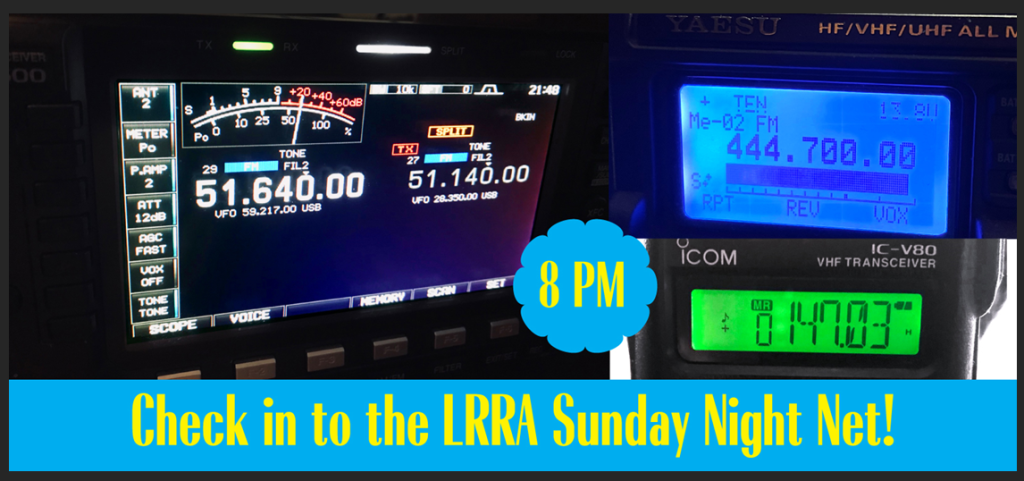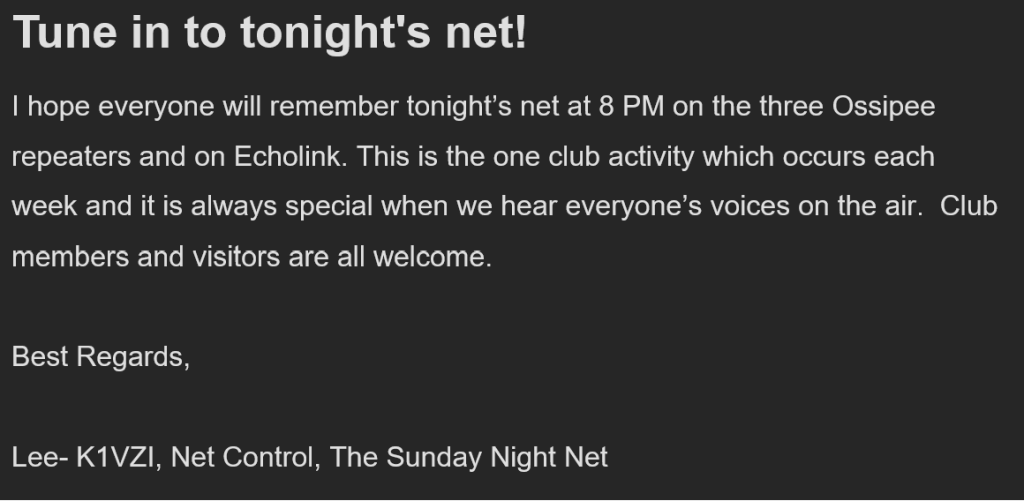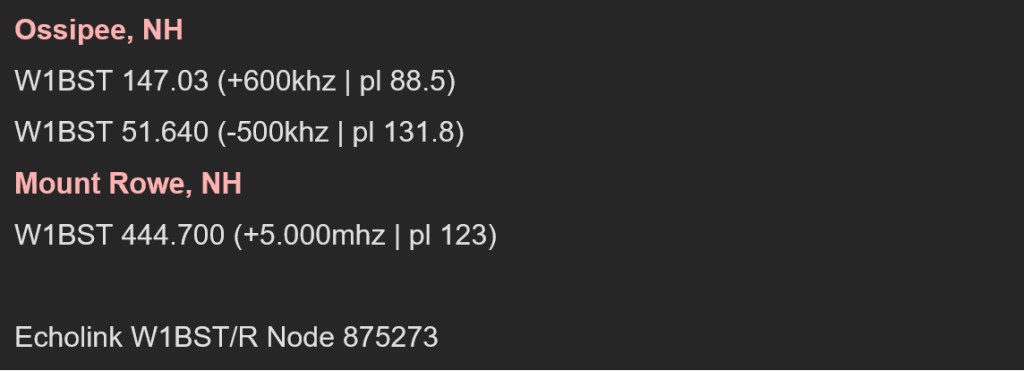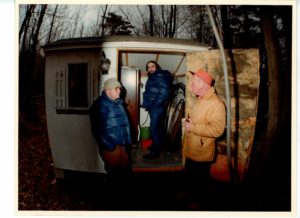




______________________
Friday night net @8pm.
442.100 repeater (PL100) in digital mode (analog, C4FM) linked with Wolfe Den (6 meter FM, [51.64 MHz Output / 51.14 MHz Input -500 kHz]) network.
Other frequencies of interest in the Lakes Region:
Daily QSO frequencies:
Each morning @ 5:30am on 29.050 MHz AM simplex.
6AM + 6PM 50.20 MHz USB simplex.
Each evening @ 7:30pm on 29.050 MHz AM simplex.
Other Local Nets:
CNHARC Nets:
Wednesday: ARES Net, 8 PM , Cliff N1RCQ Net control, 146.9850 – (123 Hz)
Thursday: Six-meter Net, 8 PM , Chris N1HD Net control, 53.770 – (71.9 Hz)
… And don’t forget the Citizen’s Bands.
While they don’t use repeaters, there are two CB nets (in action from the 70s) that may be of local interest:
America Net: Wed 8-9 PM CB Channel 36 (27.36500 MHz Lower Sideband). Net control is Jamieson 9America18
NH Side Band Net: Thur 8-9PM CB Channel 36 (27.36500 MHz Lower Sideband) LRRA’s Vice President Johnathan/KB1COL is Net Control for this net.
Note: The LRRA is not formally associated with the above entities. This information is provided solely in the interest of advancing radio science and the enjoyment of the RF spectrum.
The Citizen’s Band Radio Service
The Citizen’s Band Radio Service, also known simply as CB, is a public, two-way personal radio service. There are several classifications of CB operation. The best-known form of CB is voice communications that became popular in the 1970s.
Mobile CB operation, especially in cars and trucks, remains popular. To a lesser extent, “CB’ers” engage in fixed operation from homes, and in portable communications using handheld transceivers.
The CB Radio spectrum is broken up into 40 channels with CB frequencies ranging from 26.965 to 27.405 MHz. Channels are generally spaced 10 kHz apart.
Channel 9 (reserved for emergency communications) and Channel 19, which is mostly used by truckers. If you want specific information or want to share messages on these channels, you are welcome to do so or just switch over for a listen.
A citizens band (CB) radio antenna is a device designed to do two things: It captures radio-frequency signals that are then converted to electrical signals by the receiver, and it takes electrical signals from the transmitter and converts them into radio-frequency signals.
This second function is where tuning comes into play, because an antenna has to radiate radio-frequency signals, something that’s done best when the length of the antenna precisely matches the wavelength of the transmitted radio frequency.
Many of today’s hams got their start in CB and many are still involved.

Ham Radio Spectrum
Ham radio uses the power of electromagnetic radiation to send voices, cw, also known as Morse code and digital data around the world with the help of antennas, receivers, and transmitters.
Electromagnetic radiation travels in the form of sinusoidal waves. You can break the electromagnetic spectrum into seven areas which are categorized by or of decreasing wavelength.
They are radio waves, microwaves, in frayed, ultraviolet, x-rays, and gamma rays. Hams operate in the radio wave spectrum. The radio wave spectrum can range from 0.04 to more than 62 miles. The radio frequencies can be broken down into another spectrum called the radio frequency spectrum.
This spectrum has been sliced up by the FCC to reserve specific bands for specific radio technology. For hams, the FCC allocated frequency that start at the AM radio band at 1.6 MHz and end at 124 MHz this range includes 2 radio frequency bands VHF and UHF.
